Abstract
It has been known for a decade that human intestinal flora include organisms capable of 21-dehydroxylating corticoids. Yet the identity of the organisms synthesizing 21-dehydroxylase has remained unknown. Using diluted human feces, we determined the prevalence of colonies of 21-dehydroxylating organisms on a variety of media. Isolation from the medium of colonies with the highest prevalence yielded an obligate anaerobe capable of 21-dehydroxylating deoxycorticosterone and tetrahydrodeoxycorticosterone. This transformation could be carried out in a prereduced medium by the microbial culture alone or in an aerobic medium reduced by growth of Escherichia coli. The culture shares many characteristics with Eubacterium lentum, the neotype strain of which elaborated both 21-dehydroxylase and 3alpha-hydroxysteroid dehydrogenase.
Full text
PDF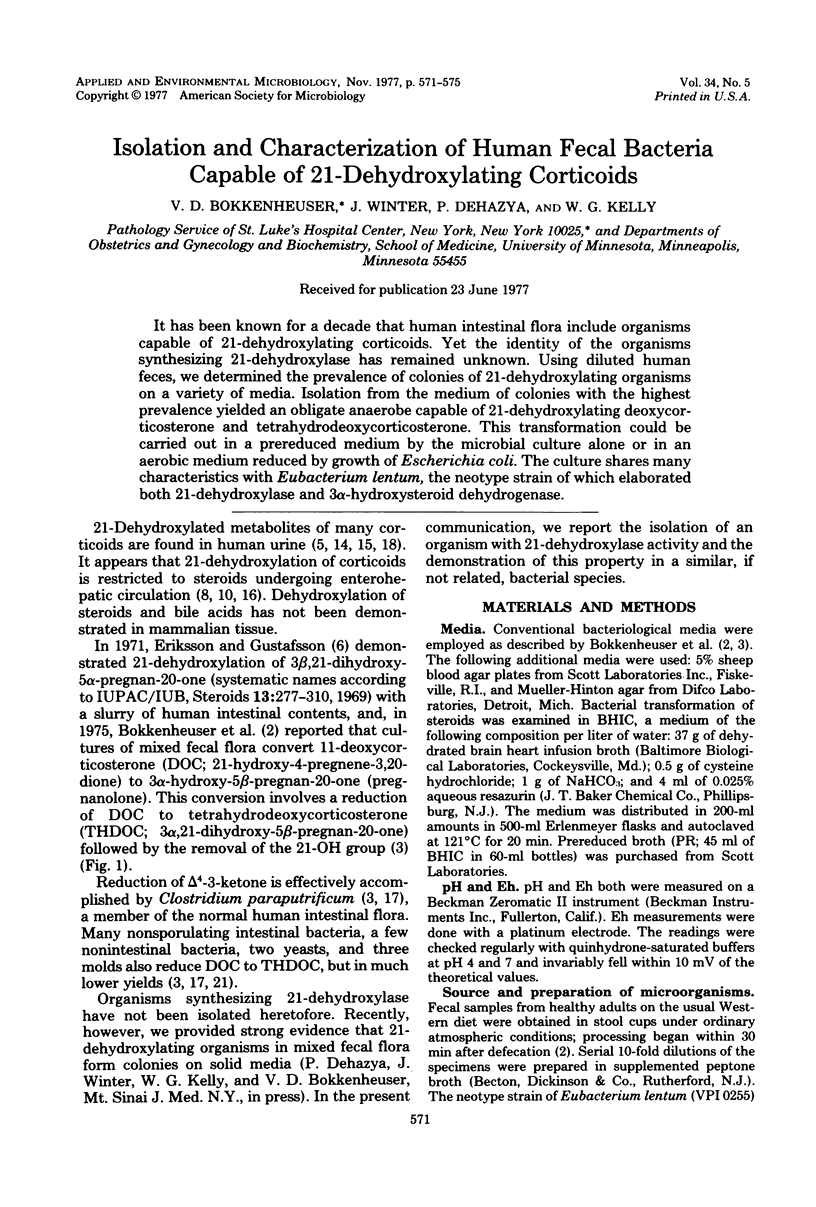
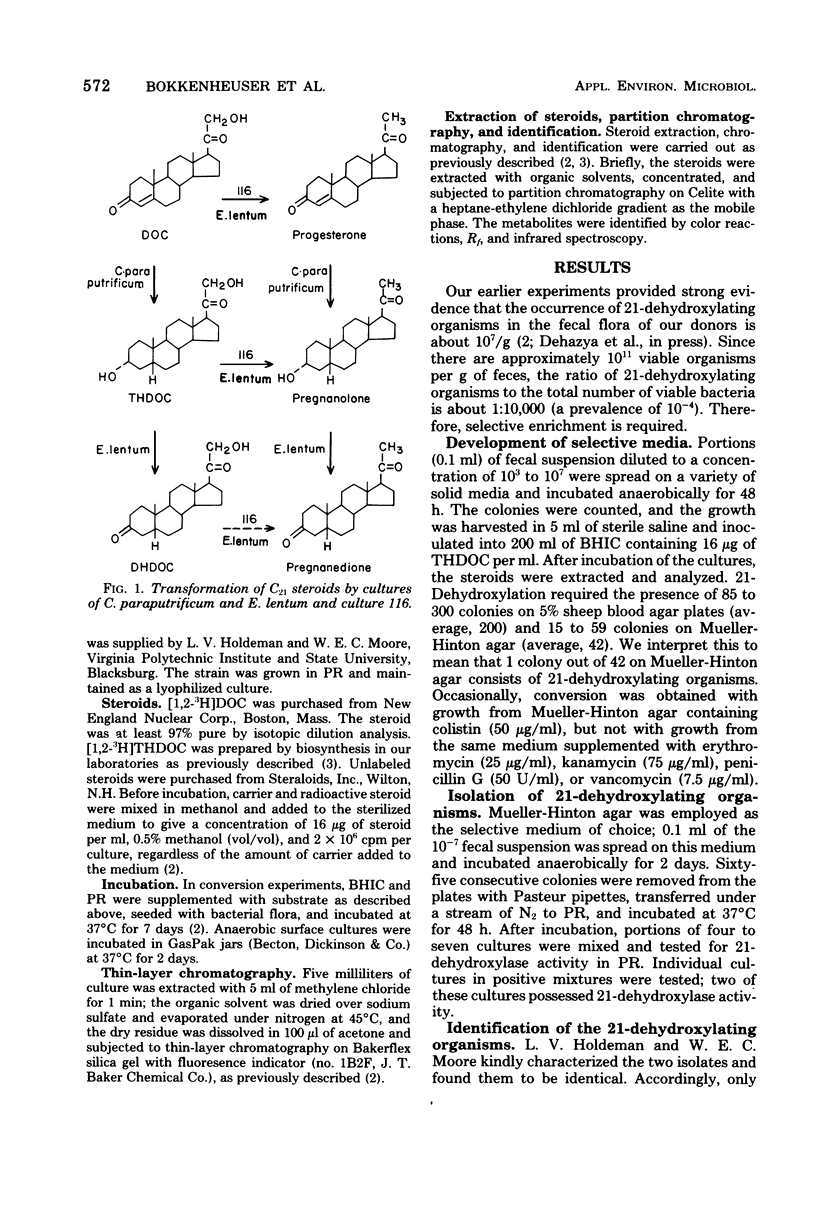
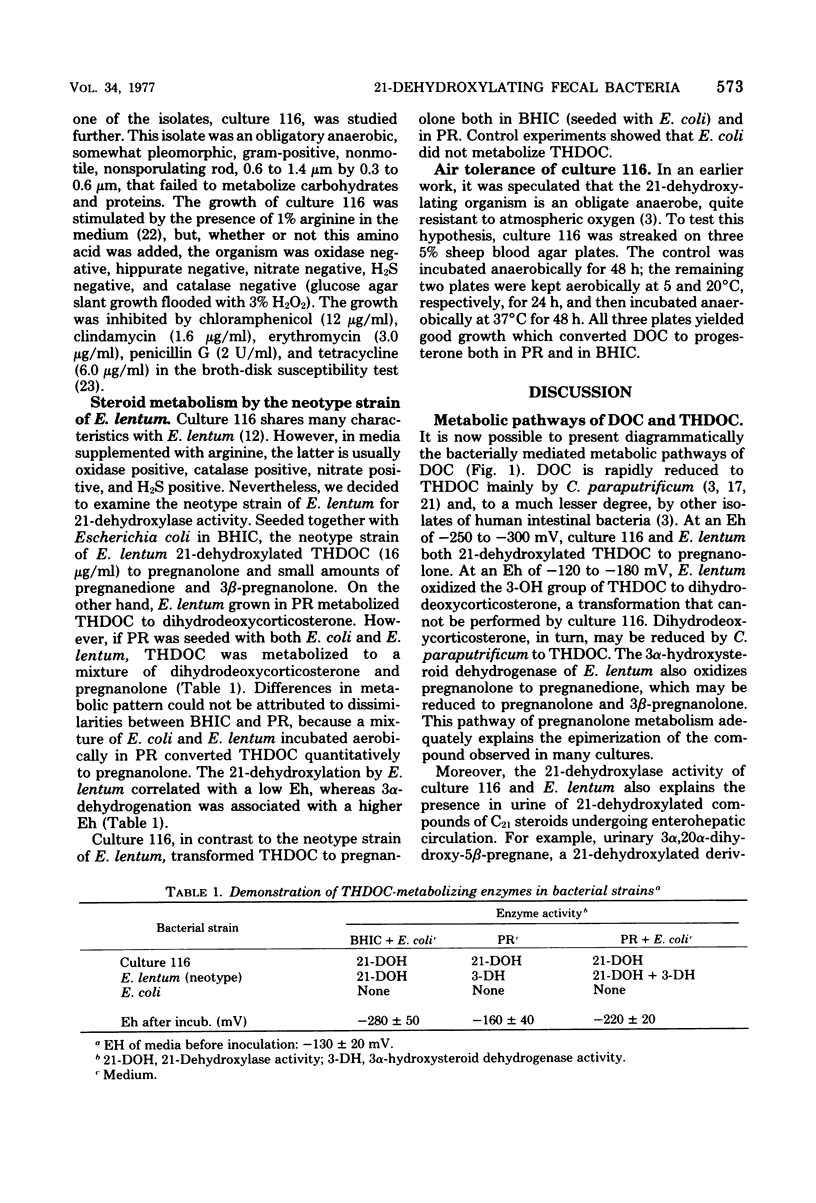
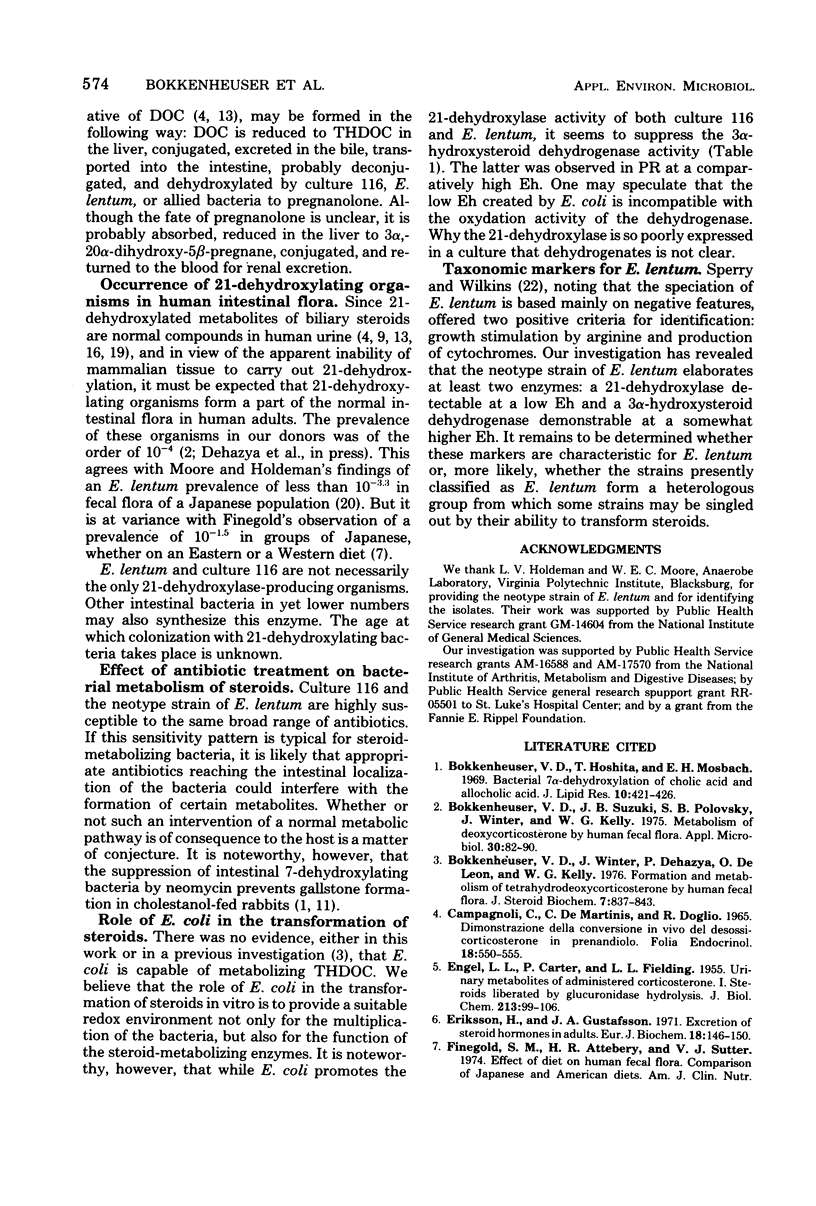
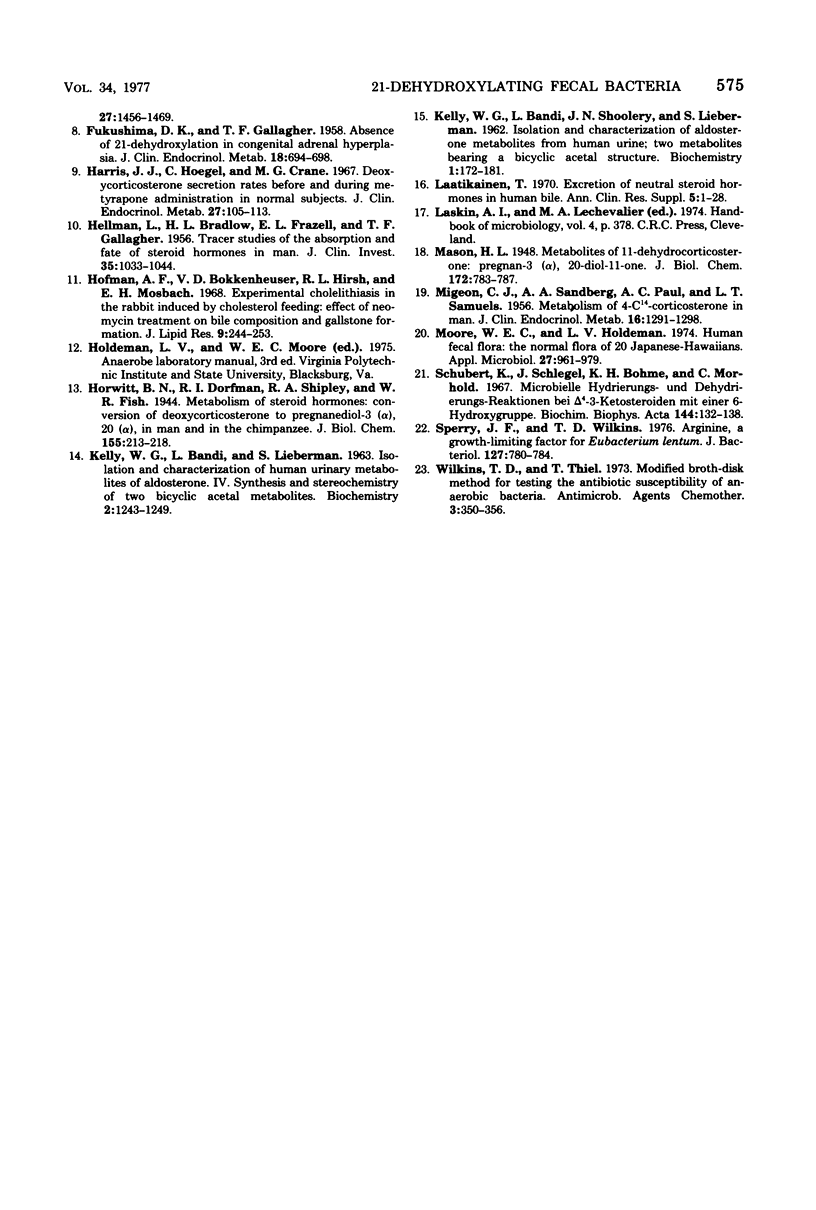
Selected References
These references are in PubMed. This may not be the complete list of references from this article.
- BRADLOW H. L., FRAZELL E. L., GALLAGHER T. F., HELLMAN L. Tracer studies of the absorption and fate of steroid hormones in man. J Clin Invest. 1956 Sep;35(9):1033–1044. doi: 10.1172/JCI103349. [DOI] [PMC free article] [PubMed] [Google Scholar]
- Bokkenheuser V. D., Suzuki J. B., Polovsky S. B., Winter J., Kelly W. G. Metabolism of deoxycorticosterone by human fecal flora. Appl Microbiol. 1975 Jul;30(1):82–90. doi: 10.1128/am.30.1.82-90.1975. [DOI] [PMC free article] [PubMed] [Google Scholar]
- Bokkenheuser V. D., Winter J., Dehazya P., de Leon O., Kelly W. G. Formation and metabolism of tetrahydrodeoxycorticosterone by human fecal flora. J Steroid Biochem. 1976 Oct;7(10):837–843. doi: 10.1016/0022-4731(76)90187-4. [DOI] [PubMed] [Google Scholar]
- Bokkenheuser V., Hoshita T., Mosbach E. H. Bacterial 7-dehydroxylation of cholic acid and allocholic acid. J Lipid Res. 1969 Jul;10(4):421–426. [PubMed] [Google Scholar]
- Campagnoli C., De Martinis C., Doglio R. Dimostrazione della conversione in vivo del desossicorticosterone in pregnandiolo. Folia Endocrinol. 1965 Oct;18(5):550–555. [PubMed] [Google Scholar]
- ENGEL L. L., CARTER P., FIELDING L. L. Urinary metabolites of administered corticosterone. I. Steroids liberated by glucuronidase hydrolysis. J Biol Chem. 1955 Mar;213(1):99–106. [PubMed] [Google Scholar]
- Eriksson H., Gustafsson J. A. Excretion of steroid hormones in adults. Steroids in faeces from adults. Eur J Biochem. 1971 Jan 1;18(1):146–150. doi: 10.1111/j.1432-1033.1971.tb01225.x. [DOI] [PubMed] [Google Scholar]
- FUKUSHIMA D. K., GALLAGER T. F. Absence of 21-dehydroxylation in congenital adrenal hyperplasia. J Clin Endocrinol Metab. 1958 Jul;18(7):694–698. doi: 10.1210/jcem-18-7-694. [DOI] [PubMed] [Google Scholar]
- Harris J. J., Hoegel C., Crane M. G. Deoxycorticosterone secretion rates before and during metyrapone administration in normal subjects. J Clin Endocrinol Metab. 1967 Jan;27(1):105–113. doi: 10.1210/jcem-27-1-106. [DOI] [PubMed] [Google Scholar]
- Hofmann A. F., Bokkenheuser V., Hirsch R. L., Mosbach E. H. Experimental cholelithiasis in the rabbit induced by cholestanol feeding: effect of neomycin treatment on bile composition and gallstone formation. J Lipid Res. 1968 Mar;9(2):244–253. [PubMed] [Google Scholar]
- KELLY W. G., BANDI L., LIEBERMAN S. ISOLATION AND CHARACTERIZATION OF HUMAN URINARY METABOLITES OF ALDOSTERONE. IV. THE SYNTHESIS AND STEREOCHEMISTRY OF TWO BICYCLIC ACETAL METABOLITES. Biochemistry. 1963 Nov-Dec;2:1243–1249. doi: 10.1021/bi00906a012. [DOI] [PubMed] [Google Scholar]
- KELLY W. G., BANDI L., SHOOLERY J. N., LIEBERMAN S. Isolation and characterization of aldosterone metabolites from human urine; two metabolites bearing a bicyclic acetal structure. Biochemistry. 1962 Jan;1:172–181. doi: 10.1021/bi00907a026. [DOI] [PubMed] [Google Scholar]
- Laatikainen T. Excretion of neutral steroid hormones in human bile. Ann Clin Res. 1970;2(Suppl):1–28. [PubMed] [Google Scholar]
- MIGEON C. J., PAUL A. C., SAMUELS L. T., SANDBERG A. A. Metabolism of 4-C14-corticosterone in man. J Clin Endocrinol Metab. 1956 Oct;16(10):1291–1298. doi: 10.1210/jcem-16-10-1291. [DOI] [PubMed] [Google Scholar]
- Moore W. E., Holdeman L. V. Human fecal flora: the normal flora of 20 Japanese-Hawaiians. Appl Microbiol. 1974 May;27(5):961–979. doi: 10.1128/am.27.5.961-979.1974. [DOI] [PMC free article] [PubMed] [Google Scholar]
- Schubert K., Schlegel J., Böhme K. H., Hörhold C. Mikrobielle hydrierungs- und dehydrierungs-Reaktionen bei delta 4-3-Ketosteroiden mit einer 6-Hydroxygruppe. Biochim Biophys Acta. 1967 Aug 8;144(1):132–138. [PubMed] [Google Scholar]
- Sperry J. F., Wilkins T. D. Arginine, a growth-limiting factor for Eubacterium lentum. J Bacteriol. 1976 Aug;127(2):780–784. doi: 10.1128/jb.127.2.780-784.1976. [DOI] [PMC free article] [PubMed] [Google Scholar]
- Wilkins T. D., Thiel T. Modified broth-disk method for testing the antibiotic susceptibility of anaerobic bacteria. Antimicrob Agents Chemother. 1973 Mar;3(3):350–356. doi: 10.1128/aac.3.3.350. [DOI] [PMC free article] [PubMed] [Google Scholar]


